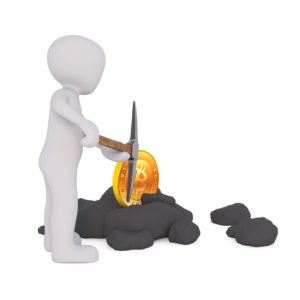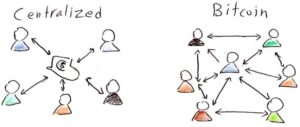
As we begin this article, I want to start out by stating that is will be another “mile high” view of exactly what a Blockchain exactly is.
To have a greater understanding of Cryptocurrency as a whole, you need to understand the technology behind it.
This is the BlockChain.
BlockChain is not holey new tech, but a combination of established tech used in such a way as it is profound technology.
Wikipedia defines Blockchain as:
“A blockchain is a continuously growing list of records, called blocks, which are linked and secured using cryptography. Each block typically contains a cryptographic hash of the previous block, a timestamp, and transaction data. By design, a blockchain is resistant to modification of the data. It is “an open, distributed ledger that can record transactions between two parties efficiently and in a verifiable and permanent way”. For use as a distributed ledger, a blockchain is typically managed by a peer-to-peer network collectively adhering to a protocol for inter-node communication and validating new blocks. Once recorded, the data in any given block cannot be altered retroactively without alteration of all subsequent blocks, which requires collusion of the network majority.”
Did you get all of that?
It can be a bit confusing, after all, as of the writing of this article, Blockchain is less than 10 years old.
BlockChain – Revolutionary Technology
Cryptocurrency is considered a disruptive technology.
Wikiiprdia describes this disruptive technology or innovation as:
“A Disruptive innovation is an innovation that creates a new market and value network and eventually disrupts an existing market and value network, displacing established market-leading firms, products, and alliances.”
I know what you’re thinking…. “OK, great, so what does that mean?”
Let’s try to put it into perspective relative to today’s technology.
Before the advent of the internet, if you needed to find out information, you went to a library.
Once you got there, you then had to look through files to find the book you needed to give you the information you were seeking.
Or of course, for those of you who are as old as I am, maybe your parents purchased you a set of “Encyclopeadia Britannica” for your home.
Anyway… before I digress too far…
So, when the internet came on the scene, you could log on from the comfort your home and search around for the information you required.

What happened next, email came on the scene.
Email was a disruptive technology.
It allowed you to send a letter from person to person without the use of the postal service.
The disruption didn’t stop there…
Then came the various programs, of which the most popular is Skype, that allow you to talk with someone on the other side of the planet for free.
Enter Cryptocurrency
Now, you might be thinking, sending money digitally has been around since the internet became a household commodity… and you would be right.
However, Cryptocurrency differs due to the tech behind it.
Let’s face it, for all intents and purposes, when you break cryptocurrencies down to their most basic form, they are a shared database or ledger called a Blockchain.
Decentralized Nature of BlockChain
So by now, you have heard the word “decentralized” put out there several times with respect to Bitcoin and Cryptocurrency.
So what exactly do that mean and how does it work?
For our purposes, centralized describes a single location or company which controls or posses all of an asset or information.
Think your bank. Yes, it may have more than one branch, but all the monies are held by one entity.
For our purposes, decentralized means just the opposite. All the assets or information are distributed over multiple locations.
So when transacting with cryptocurrencies, instead of using a central bank or payment processor (a trusted 3rd party to oversee the transactions), who usually charges a hefty fee – we use use the Blockchain which allows for each transaction to be done peer-to-peer without the need for a 3rd party.
To read more about a centralized vs decentralized system, Click Here
How does the BlockChain work?

The Blockchain is made up of thousands of computers around the world.
These nodes secure the network and provide a cryptographically protected public ledger of the transaction.
Because the entire transaction history is forever recorded in this ledger and there are thousands of computers around the world which come to consensus and then update the recorded ledger, there is no need for a “trusted 3rd party.”
Oh… and let’s not forget, the fees are pennies and you don’t need any government created currency (fiat currency).
Hacking into a Blockchain is near impossible.
To do so, you must control 51% of the computing power of the entire network. And even then, you can not just amend the block that contains the transaction, but every block before it.
Recording BlockChain Transactions
You might be thinking… “OK, that all sounds great… but how does this get recorded?”
We’re glad you asked!
As of the writing of this article, there are a couple of primary methods used in the CryptoCurrency space.
They are called Proof-of-Work (PoW) and Proof-of-Stake (PoS).

Proof-of-Work (PoW)
This method was first created along with Bitcoin and set in motion back in 2009.
Bitcoins as well as other similar cryptocurrencies are “mined” by computers solving complex mathematical computations.
These “miners” are provided a monetary incentive (in the form of the coin they are mining).
This process allows for the BlockChain to be in sync and secure.
Learn More About Proof-of-Work (PoW) Here
Proof-of-Stake (PoS)
This method was adopted by PeerCoin in 2013.
In a nutshell, Proof-of-Stake is a concept where a person can mine or validate Blockchain transactions and their incentive and overall validating ability is directly related to how many coins of that specific Cryptocurrency are held.
These coins are “locked up” kind of like collateral and then the owner receives periodic monetary distributions (in the form of the coin).
This process is generally considered to be “greener” environmentally speaking as it requires less power consumption than mining.
Just like mining, this process keeps the BlockChain in sync and secure.
Learn More About Proof-of-Stake (PoS) Here
Where Do You Go From Here?
Unless you are a complete techie, this is more than enough information for you to function in the Cryptocurrency space and have a working understanding of how these platforms and projects utilize Blockchain technology.
 Looking For A Job?
Looking For A Job?
Now, with that being said… if you are a tech savvy person, and you are looking for employment or just having an opportunity to work in the Cryptocurrency space, there are many projects looking for good people to move their visions forward…
And, let’s not forget, as a bonus, you can get paid to do something you enjoy while helping to develop a new economy.
Disclaimer
The information provided here is for INFORMATIONAL & EDUCATIONAL PURPOSES ONLY!
View our complete disclaimer on our Disclaimer Page



